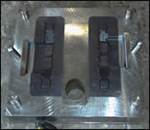Standardized Insert System Reduces Setup Times and Leadtimes
Aside load insert system has been developed by a moldmaker that works with standardized mold base systems.
Aside load insert system has been developed by a moldmaker that works with standardized mold base systems—allowing moldmakers to ship molds and mold inserts more quickly to their customers.
Kenton, OH-based Modular Mold Systems, a division of Pleasant Precision, Inc.—a moldmaker and a provider of interchangeable mold insert systems—developed the side load system in response to one of its customers who had been looking for a better way to use standardized mold base systems that are currently available. Modular Mold Systems President Ron Pleasant notes that the customer prefers a quick change system, which allows him to easily install the mold. However, Pleasant saw that the current system could work even better with some tweaking. “We decided we could standardize some aspects and then carry these products in stock,” Pleasant explains.
System Features
These systems—compatible with industry standard U-Frame sizes 08/09 and 10/12—have inserts that are standard laminated P-20 construction. Pleasant notes that solids and other steel types are available for special order. “Ejector plates are centered with the B plate and inserts are larger than standard to allow full useable space on the ejector plates,” he explains. “Inserts are still fully compatible with standard U-Frames and offer more cavity space for the ability to work with slides and accommodate larger parts.”
Pleasant notes that when the company designed the side load system, they added adjustability and standardized some of the methodologies required in the design process. “We placed everything on a true centerline and made everything a little bigger so we could get a little room in the smaller inserts,” he states. “Then the customer could get more of his product into the smaller units. Our customer wants to use all of their standard frames so we can’t really fool around with the interface side of it, but we can start to adjust some of the insert sizes above the master frame.”
“Another thing we decided was that we needed to have cover ejection,” Pleasant continues. “These parts tend to have lots of undercuts and are symmetrical. They need to come out of the cover and stick in the injector. If you don’t do that the mold will fail, so we needed a standardized method to put cover ejection in. This helped our ability to respond to those particular parts that needed cover ejection.
Applications
According to Pleasant, this system is suitable for the automotive market because the parts are small, they tend to be generically similar to each other, and they have undercuts and slides. “Often, the customer will want four, eight or 16 cavities, which tend to fit in this small insert size and it meets the customers’ ability of being a lean setup where they can change mold inserts multiple times in a week and not have a lot of setup time,” Pleasant elaborates. “Standardized mold base systems serve these requirements quite well, so by building a side load insert that fits into that already well nested product, and then adding more standards to it—allows us to become yet more competitive with our delivery times and our cost per injection mold.”
Related Content
Mold Builder Uses Counter-Intuitive Approach for Mold Challenges
Matrix Tool Inc. answers customers’ hard questions with creative solutions for cavity spacing, tool sizing, runner layout and melt delivery that reveal the benefits of running in a smaller press size at lower cavitation but higher yield.
Read MoreOEE Monitoring System Addresses Root Cause of Machine Downtime
Unique sensor and patent-pending algorithm of the Amper machine analytics system measures current draw to quickly and inexpensively inform manufacturers which machines are down and why.
Read MoreEditorial Guidelines: Editorial Advisory Board
The Editorial Advisory Board of MoldMaking Technology is made up of authorities with expertise within their respective business, industry, technology and profession. Their role is to advise on timely issues, trends, advances in the field, offer editorial thought and direction, review and comment on specific articles and generally act as a sounding board and a conscience for the publication.
Read MoreLeading Mold Manufacturers Share Best Practices for Improving Efficiency
Precise Tooling Solutions, X-Cell Tool and Mold, M&M Tool and Mold, Ameritech Die & Mold, and Cavalier Tool & Manufacturing, sit down for a fast-paced Q&A focused on strategies for improving efficiencies across their operations.
Read MoreRead Next
How to Increase Polishing Efficiencies
A concurrent approach to polishing increases the man-and-machine efficiency while streamlining workflow to help attain ever-decreasing leadtimes.
Read MoreReasons to Use Fiber Lasers for Mold Cleaning
Fiber lasers offer a simplicity, speed, control and portability, minimizing mold cleaning risks.
Read MoreHow to Use Continuing Education to Remain Competitive in Moldmaking
Continued training helps moldmakers make tooling decisions and properly use the latest cutting tool to efficiently machine high-quality molds.
Read More.jpg;maxWidth=970;quality=90)







.png;maxWidth=300;quality=90)
.jpg;maxWidth=300;quality=90)



_300x250 1.png;maxWidth=300;quality=90)









